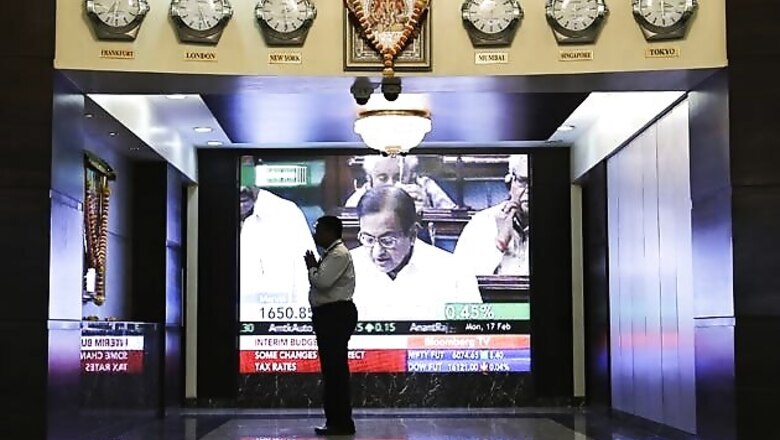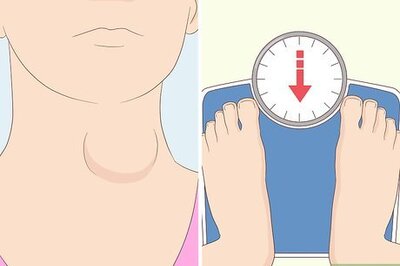
views
Riding high on the development agenda, Narendra Modi led Bharatiya Janata Party triumphed the Lok Sabha elections with a thunderous applause in May 2014. Nine months later, in its first full-fledged Union budget, it is time for the Modi government to put into action the tall promises made during elections.
Soon after coming to power at the Centre, Finance Minister Arun Jaitley in an interim budget presented on 10 July, 2014 claimed that slow decision making by the previous Congress-led United Progressive Alliance government had resulted in loss of opportunity and challenges for the economy.
Some of the several assurances that Modi made to the people were to bring down inflation, more investment, economic upswing and to bring back black money stashed abroad. As Jaitley prepares to present his first budget, all eyes will be on which of the promises will see the light of the day when he opens his briefcase on February 28.
While the Modi government had come to power with an aim of 'minimum government, maximum governance', just a few days before the unveiling of the Budget, Reserve Bank of India Governor Raghuram Rajan explicitly cautioned that a strong government may not always move in the right direction. Rajan suggested the need to tread a middle path between unchecked powers to the administration and a "complete paralysis".
However, in the run up to the budget, the markets are reflecting a positive mood with the benchmark index of Indian equities markets gaining 136.48 points in the week that ended on February 20. Sensex also closed 136.48 points up at 29,231.41 in the weekly trade.
"Budget of this NDA government is to lay down a broad policy indicator of the direction in which we wish to take this country," Jaitley had said while presenting the interim budget. It is to be seen if the Modi government's first 'full' budget will have significant plans to portray this thought and if steps are taken to achieve the 7-8 per cent economic growth rate that they have assured.
Here is a crisp comparison of the past five union budgets and their highlights over the years.
Key Features of Budget 2014-2015 (PART 2)
FINANCE MINISTER: Arun Jaitley
The government's commitment to the principle of "Minimum Government Maximum Governance" remained the priority of Arun Jaitley's interim Budget. He also assured the investors community of the government's commitment to spur growth.
Foreign Direct Investment: NDA government focused its attention to promote Foreign Direct Investment (FDI) selectively in sectors where it helps the larger interest of the economy.
Insurance: Increase in composite cap in Insurance sector increased up to 49 per cent from the current level of 26 per cent.
Swatchh Bharat Abhiyan: With the intention of covering every household by total sanitation by the year 2019, government launched the Swatchh Bharat Abhiyan.
Pension scheme: NDA Government during its last term in office had introduced the Varishtha Pension Bima Yojana (VPBY) as a pension scheme for senior citizens. The government revived the scheme for a limited period from 15 August, 2014 to 14 August, 2015 for the benefit of citizens aged 60 years and above.
Women safety: An outlay of Rs 50 crores allotted for Ministry of Road Transport & Highways on pilot testing a scheme on "Safety for Women on Public Road Transport". A sum of ` 150 crores will also be spent by Ministry of Home Affairs on a scheme to increase the safety of women in large cities.
Education: Launch of Beti Bachao, Beti Padhao Yojana to help in generating awareness and also help for women, sum of Rs 100 crore assigned for the same. Additional amount also granted for Sarva Shiksha Abhiyan and Rashtriya Madhyamik Shiksha Abhiyan.
Digital India: Launch of a pan India programme "Digital India" to focus on the need to bridge the divide between digital "haves" and "have-nots".
Housing: To endeavour to have housing for all by 2022, an extension of additional tax incentive on home loans to encourage people, especially the young, to own houses.
Agriculture: The budget focussed on the urgent need to step up investment in agro-technology development and creation and modernization of existing agri-business infrastructure. Steps to tackle deteriorating soil health and climate change to be taken.
Special Economic Zones: Revival of Special Economic Zones (SEZs) and to make them effective instruments of industrial production.
Banking: To energize markets, uniform KYC norms and inter-usability of the KYC introduced and one single operating demat account for financial transactions to be used.
Defence: Allocation of Rs 2,29,000 crore for the current financial year for Defence and One Rank One Pension and war memorials to be made.
Clean Ganga: To expedite the preparation of the Detailed Project Reports on linking of Rivers and Ghat development and beautification of river front at Kedarnath, Haridwar, Kanpur, Varanasi, Allahabad, Patna and Delhi.
Direct Taxes
Increase personal income tax exemption limit by Rs 50,000 that is, from Rs 2 lakh to Rs 2.5 lakh in the case of individual taxpayers who are below the age of 60 years. Increase in exemption limit from Rs 2.5 lakh to Rs 3 lakh for senior citizens.
Key Features of Budget 2014-2015 (Part 1)
FINANCE MINISTER: P. Chidambaram
The state of world economy has been the most decisive factor affecting the fortunes of every developing country. The world economy had been witnessing a sliding trend in growth, from 3.9 per cent in 2011 to 3.1 per cent in 2012 and 3 per cent in 2013.
With an aim to give an overview of the past 10 years of governance by the UPA government, Chidambaram stated that despite a decline in growth of global trade, export recovered sharply. "UPA-I & UPA-II Governments delivered above the trend growth of 6.2 per cent, which prevailed over a period of 33 years," he said.
Railways: Budgetary support to Railways increased from Rs 26,000 crore
Defence: 10 per cent hike in Defence allocation, accepted principle of one rank one pension for the Defence Forces to be implemented prospectively from the FY 2014-15.
Minorities: The number of bank accounts of minorities has increased to 43,52,000 at the end of March 2013 from 14,15,000 ten years ago.
Education: Moratorium period proposed for all education loans taken up to 31.3.2009 and outstanding on 31.12.2013. Government to take over the liability for outstanding interest as on 31.12.2013. The National Skill Certification and monetary reward schemes launched in August 2013, an additional sum of Rs 1000 crore proposed to scale up its programme rapidly.
Assistance to States: Rs 1200 crore allotted as additional central assistance to North Eastern states, Himachal Pradesh and Uttarakhand in this financial year.
Women security: A Corpus has been created for 'Nirbhaya Fund' with a non lapsable grant of Rs 1000 crore. 2 Proposals to ensure the dignity and safety of women approved.
Indirect tax:
-States to partner in development so as to enable the Centre to focus on Defence,
Railways, National Highways and Tele-communication.
-To give relief to the Automobile Industry, which is registering unprecedented negative
growth
Key Features of Budget 2013-2014
FINANCE MINISTER: Pranab Mukherjee
The main aim of the government was its battle against inflation. Pranab Mukerjee had stated that Budget for 2013-14's overarching goal was to create opportunities for youth to acquire education and skills for decent jobs or selfemployment. A standing Council of Experts was proposed to be constituted in the Ministry of Finance to analyse the international competitiveness of the Indian financial sector.
Minority: An increase of 12 per cent over the BE and 60 per cent over the RE of 2012-13 to Ministry of Minority Affairs. Allocation of Rs 160 crore to the corpus of Maulana Azad Education Foundation to raise its corpus to Rs 1,500 crore during 12th Plan period.
Health: Rs 37,330 crore allocated to the Ministry of Health & Family Welfare. New National Health Mission allocated Rs 21,239 crore. Rs 1,650 crore allocated for six AIIMS-like institutions.
Rural Development: Allocation of ` 80,194 crore in 2013-14 for Ministry of Rural Development marking an increase of 46% over RE 2012-13.
Agriculture: Rs 27,049 crore allocated to Ministry of Agriculture, an increase of 22 per cent over the RE of current year
Savings: Additional deduction of interest upto Rs 1 lakh for a person taking first home loan upto Rs 25 lakh during period 1.4.2013 to 31.3.2014.
Micro, Small and Medium Enterprises: Benefits or preferences enjoyed by MSME to continue upto three years after they grow out of this category. Refinancing capacity of SIDBI raised to Rs 10,000 crore.
Defence: Allocation for Defence increased to Rs 2,03,672 crore including Rs 86,741 crore for capital expenditure.
Women security: "Nirbhaya Fund" - to be setup with Government contribution of ` 1,000 crore to empower women and to keep them safe.
- National Skill Development Corporation to set the curriculum and standards for training in different skills.
- For the poor of India, direct benefit transfer scheme rolled out throughout the country during the term of the UPA Government with the motive "Äapka paisa aapke haath".
Direct taxes:
Mukherjee said that there was little room to give away tax revenues or raise tax rates in a constrained economy. There was no revision in either the slabs or the rates of Personal Income Tax.
However, relief was given to Tax Payers in the first bracket of Rs 2 lakh to Rs 5 lakhs and a tax credit of Rs 2000 to every person with total income upto Rs 5 lakhs. Surcharge of 10 per cent allotted on persons (other than companies) whose taxable income exceeded Rs 1 crore to augment revenues.
Indirect Taxes
No change in the normal rates of 12 percent for excise duty and service tax or in the peak rate of basic customs duty of 10 per cent for non-agricultural products.
Key Features of Budget 2012-2013
FINANCE MINISTER: Pranab Mukherjee
For Indian economy, recovery was interrupted this year due to intensification of debt crises in Euro zone, political turmoil in Middle East, rise in crude oil price and earthquake in Japan. GDP was estimated to grow by 6.9 per cent in 2011-12, after having grown at 8.4 per cent in preceding two years.
Foreign Direct Investment: To strengthen investment environment, a decision to allow FDI in multi-brand retail upto 51 per cent proposed.
Advance Pricing Agreement: Provision regarding implementation of Advance Pricing Agreement introduced in Finance Bill, 2012.
Capital Market: Various steps proposed to be taken for deepening the reforms in the Capital markets, including simplifying process of IPOs, allowing QFIs to access Indian Bond Market etc.
Legislative Reforms: Official amendment to "The Pension Fund Regulatory and Development Authority Bill, 2011", "The Banking Laws (Amendment) Bill, 2011" and "The Insurance Law (Amendment) Bill, 2008" to be moved.
Housing Sector: Various proposals to address the shortage of housing for low income groups in major cities and towns including allowing ECB for low cost housing projects and setting up of a credit guarantee trust fund etc.
Food Security: National Food Security Bill, 2011 placed before Parliamentary Standing Committee. A national information utility for computerisation of PDS under operation being created, to become operational by December, 2012.
Social security: In the ongoing Indira Gandhi National Widow Pension Scheme and Indira Gandhi National Disability Pension Scheme for BPL beneficiaries, pension amount to be raised from Rs 200 to Rs 300 per month. Lump sum grant on the death of primary breadwinner of a BPL family, in the age group 18-64 years, doubled to Rs 20,000.
Defence: A provision of Rs 1,93,407 crore made for Defence services including Rs 79,579 crore for capital expenditure.
Black Money: Proposal to lay a White Paper on Black Money in placed in the current session of Parliament.
Direct taxes:
Exemption limit for the general category of individual taxpayers enhanced from Rs 1,80,000 to Rs 2,00,000 giving tax relief of Rs 2,000. Upper limit of 20 per cent tax slab proposed to be raised from Rs 8 lakh to Rs 10 lakh. Individual tax payers allowed a deduction of upto Rs 10,000 for interest from savings bank accounts.
Indirect Taxes
Given the imperative for fiscal correction, standard rate of excise duty raised from 10 per cent to 12 per cent. Excise duty on large cars also enhanced.
Key Features of Budget 2011-2012
FINANCE MINISTER: Pranab Mukherjee
In the Budget, the finance Minister claimed that swift and broad based growth in 2010-11 placed the economy back to its pre-crisis growth trajectory. Gross Domestic Product (GDP) estimated to have grown at 8.6 per cent in 2010-11 in real terms.
However, continued high food prices remained to be the principal concern in the year. Consumers were denied the benefit of seasonal fall in prices despite improved availability of food items, revealing shortcomings in distribution and marketing systems.
Subsidies: Government moved direct transfer of cash subsidy for people living below poverty line in a phased manner for better delivery of kerosene, LPG and fertilisers.
Micro Finance Institutions: "India Microfinance Equity Fund" of Rs 100 crore to be created with SIDBI. Government considering putting in place appropriate regulatory framework to protect the interest of small borrowers.
Housing: Existing scheme of interest subvention of 1 per cent on housing loan liberalised. Existing housing loan limit enhanced to Rs 25 lakh for dwelling units under priority sector lending.
Agriculture: The main focus of the government was on the agriculture section. Allocation under Rashtriya Krishi Vikas Yojana (RKVY) increased from Rs 6,755 crore to Rs 7,860 crore and credit flow for farmers was raised from Rs 3,75,000 crore to Rs 4,75,000 crore in 2011-12.
Black money: Five-fold strategy proposed to deal with the problem of generation and circulation of black money. Finance Ministry commissioned study on unaccounted income and wealth held within and outside the country.
Education: Allocation for education increased by 24 per cent over current year. Rs 21,000 crore allocated for Sarva Shiksha Abhiyan, which is 40 per cent higher than Budget for 2010-11
Clean Energy Fund: Special allocation of Rs 200 crore provided for clean-up of some more important lakes and rivers other than Ganga.
Direct Taxes
Exemption limit for the general category of individual taxpayers enhanced from Rs 1,60,000 to Rs 1,80,000 giving uniform tax relief of Rs 2,000. Exemption limit enhanced and qualifying age reduced for senior citizens. Higher exemption limit for Very Senior Citizens, who are 80 years or above.
Indirect Taxes
Central Excise Duty maintained at standard rate of 10 per cent. Lower rate of Central Excise Duty enhanced from 4 per cent to 5 per cent.####



















Comments
0 comment